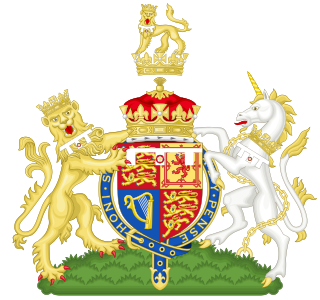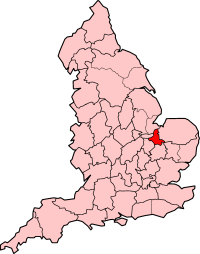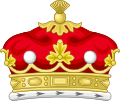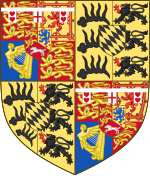Duke of Cornwall is a title in the Peerage of England, traditionally held by the eldest son of the reigning British monarch, previously the English monarch. The duchy of Cornwall was the first duchy created in England and was established by a royal charter in 1337. Prince William became Duke of Cornwall following the accession of his father, King Charles III, to the throne in 2022, and his wife, Catherine, became Duchess of Cornwall.

Duke of Edinburgh, named after the city of Edinburgh in Scotland, is a substantive title that has been created four times since 1726 for members of the British royal family. It does not include any territorial landholdings and does not produce any revenue for the title-holder.

Duke of York is a title of nobility in the Peerage of the United Kingdom. Since the 15th century, it has, when granted, usually been given to the second son of English monarchs. The equivalent title in the Scottish peerage was Duke of Albany. However, King George II and King George III granted the titles Duke of York and Albany.

Duke of Gloucester is a British royal title, often conferred on one of the sons of the reigning monarch. The first four creations were in the Peerage of England and the last in the Peerage of the United Kingdom; the current creation carries with it the subsidiary titles of Earl of Ulster and Baron Culloden.

The Isle of Ely is a historic region around the city of Ely in Cambridgeshire, England. Between 1889 and 1965, it formed an administrative county.

Duke of Wellington is a title in the Peerage of the United Kingdom. The name derived from Wellington in Somerset. The title was created in 1814 for Arthur Wellesley, 1st Marquess of Wellington, the Anglo-Irish military commander who is best known for leading the decisive victory with Field Marshal von Blücher over Napoleon's forces at Waterloo in Brabant. Wellesley later served twice as British prime minister.

Duke of Cambridge, one of several current royal dukedoms in the United Kingdom as of 2022, is a hereditary title of specific rank of nobility in the British royal family. The title is heritable by male descendants by primogeniture, and has been conferred upon members of the British royal family several times.
Duke of Cumberland is a peerage title that was conferred upon junior members of the British Royal Family, named after the historic county of Cumberland.
The Peerage of Great Britain comprises all extant peerages created in the Kingdom of Great Britain between the Acts of Union 1707 and the Acts of Union 1800. It replaced the Peerage of England and the Peerage of Scotland, but was itself replaced by the Peerage of the United Kingdom in 1801.
The Peerage of the United Kingdom is one of the five Peerages in the United Kingdom. It comprises most peerages created in the United Kingdom of Great Britain and Ireland after the Acts of Union in 1801, when it replaced the Peerage of Great Britain. New peers continued to be created in the Peerage of Ireland until 1898.

Marquess of Cambridge was a title that was created twice, once in the Peerage of England and once in the Peerage of the United Kingdom.
The hereditary peers form part of the peerage in the United Kingdom. As of March 2023, there are 807 hereditary peers: 30 dukes, 34 marquesses, 189 earls, 111 viscounts, and 443 barons.

The title of Earl of Inverness was first created in 1718 in the Jacobite Peerage of Scotland, together with the titles Viscount of Innerpaphrie and Lord Cromlix and Erne, by James Francis Edward Stuart for the Honourable John Hay of Cromlix, third son of the 7th Earl of Kinnoull. He was created Duke of Inverness in 1727, but both titles became extinct upon the death of the grantee in 1740.
The title of Earl of Cambridge was created several times in the Peerage of England, and since 1362 the title has been closely associated with the Royal family.
Earl of Dublin is a title that has been created three times in British and Irish history.
The peerage title of Viscount Launceston, named for Launceston in Cornwall, has been twice created, each time for an individual connected with the British Royal Family.

Earl of Ormond was a title twice created in the Peerage of Scotland, both times for members of the Douglas family. The related title Marquess of Ormond was created twice in the Peerage of Scotland for members of the House of Stuart.

Marquess is a rank of nobility in the peerages of the United Kingdom.

Duchess of Edinburgh is the principal courtesy title held by the wife of the Duke of Edinburgh. There have been five Duchesses of Edinburgh since the title's creation. Following the accession of Charles III in 2022, the Dukedom of Edinburgh merged in the Crown. Following his parents’ wishes, on 10 March 2023, Charles III conferred the title Duke of Edinburgh to his youngest brother, Prince Edward, and his wife, Sophie, became the Duchess of Edinburgh.











